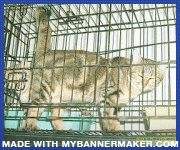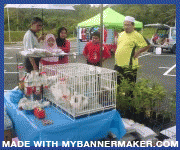Ramai yang sms atau talipon den bagaimana untuk menghadapi arnab yang diserang penyakit cirit. Berbagai petua otai-otai terdahulu berikan dan Insya Allah sekiranya betul cara mengubatinya maka akan sihat kembalilah arnab-arnab tersebut. Sebut je penyakit cirit ni, ramai penternak yang kecut perut dan fobia menghadapinya. Selalunya pengalaman akhir berakhir dengan kematian. Boleh dikatakan peluang hidup tu 80% : 20% je peluang hidup kalau dah di peringkat kritikal. Di peringkat kritikal, ubat cirit dah tak berkesan lagi, malah mempercepatkan KO jika salah kaedah pemberiannya.
Jadi di sini saya cuba paparkan kaedah yang dilakukan oleh penternak luar negara sebagai panduan kepada kita bersama. Mungkin sedikit sebanyak boleh kita jadikan panduan.
Rabbit Diarrhea Treatment
Coping With Diarrhea
Notice: I am not a veterinarian and I am not qualified to give out veterinary advice. I am only sharing my experience as a breeder.
One Sick Little Doe
My story actually starts before I discovered my sick little eight-week old doe one Thursday evening. About a week before I found my gal sitting listlessly in a puddle of watery diarrhea (possibly unformed cecal matter), I found a nestbox mate (not a related doe--both had been fostered to the same doe) in a similar situation. She was further along in her illness and died within three hours. I knew from experience that death generally follows within 24 hours of the onset of watery diarrhea. I had to act fast.
|
I have this book in my personal library and highly recommend it. It is somewhat challenging to read at times and not all remedies are available to the average rabbit owner. But if you are serious about your rabbits, you need a serious medical reference.
The sections on husbandry and nutrition are easy to read and are full of useful information.
If you live in an area that does not have a rabbit savvy vet, I highly recommend that you purchase this book so that you know when to go to the vet and have some questions and information for your vet as a place to begin discussing diagnosis and treatment of your rabbits.
|
Now I should take a moment to say that I am not talking about soft stool or excessive cecal matter (soft, smelly matter that might resemble a cluster of tiny grapes). In this case, my little doe had had a blowout of watery feces (or cecal matter) mixed with mucous and tinged with blood.
She had been in the house the evening before and seemed perfectly healthy. I had fed and checked all of the bunnies that morning and had noticed nothing out of the ordinary. But in the evening, I had decided to separate the litter from the foster mom and place the kits into cages by pairs. My timing was good. Had I decided to wait a day, I'm sure I would have been too late.
Besides the diarrhea, I noted that she was acting very strange, not moving as much as usual. And her spine poked through her fur in an alarming matter--especially considering it had not been that way the day before.
On the positive side, she did resist my holding her to inspect her, showing she had a little spunk left in her, and I found within a few minutes that she was willing to accept feedings by mouth through a syringe. Those two things told me it was worth the effort it might take to save her. The bunny the week before had refused liquids by mouth and it was even too late for subcutaneous fluid to help. But this little doe was working with me.
First Step: Rehydration
Luckily for me, Tracy Lukeman, a more experienced breeder, called just as I was determining my plan of action. We talked over several options and she gave me some ideas to try. Then I hopped on the internet to find a recipe for Oral Rehydration Therapy (ORT) solution. The solution I used follows:
1 cup clean water
2 teaspoons sugar
1/4 teaspoon baking soda
3/16 teaspoon salt (take some out of a 1/4 tsp. or use a rounded 1/8 tsp.)
This formula differed from ones I'd previously used by having baking soda in it. But because I had read that the bunny's system is probably more acid when it is sick like this, I thought it might be a good thing to include the soda. One article said that the system would be so acid that using probiotics might be useless since they would die in the high acid environment before they could colonize the colon again.
I began by putting the solution into a clean syringe and feeding her all she would take by mouth. She had two or three of these feedings before bedtime. She stayed in the house with us and we went off to bed hoping she'd be around in the morning. We left her with a dish of ORT solution, a small handful of hay, and a teaspoon of rolled oats. I was very worried about her, but hopeful that I'd be able to do more in the morning.
Friday Morning
Obviously, this story would not be a success story had she not survived the night. I was highly encouraged that she was alive, but she had not made the progress that I had hoped. I then decided to try to give her a boost with the use of Lactated Ringer's given subcutaneously. I had gotten the Lactated Ringer's from my vet for a previous bunny and had stored it in the refrigerator. I placed a gumball-size pocket of fluid on each side of the back of her neck. She didn't much care for it and I was glad to see that she was feisty enough to fight me a little.
A Little Food
We continued giving the ORT solution every hour or so. By the afternoon, she seemed to be doing better. The diarrhea had tapered off but she had had a fair amount of mucous in its place. We added bananas baby food to her diet at this point. She wasn't crazy about it, but accepted some through the syringe. I chose bananas first for two reasons. First, bananas have potassium, which I thought she might really benefit from. And second, bananas are part of the human BRAT diet, which has been suggested for me to use with my children by my pediatricians after my children have had diarrhea. BRAT stands for "bananas, rice, applesauce & toast."
The Second Evening
By the evening, her diarrhea and the mucous had stopped. She was beginning to be more active. I fed her peas baby food in addition to the ORT, hay, and oats. She did not require any more subcutaneous fluids. She began fussing around in her cage and paying attention to grooming. I was pretty sure by this time that she would make it.
Saturday: A Step Closer
The next day, we introduced carrots baby food and allowed her to take the ORT solution only in the dish as she desired. She consumed some oats, nibbled some hay and drank an acceptable amount of the ORT. She began biting the cage and tearing a the kids' artwork that invaded her space. I was glad to see her so interested in her environment. She had been almost a zombie when I first discovered she was ill.
Sunday: Getting Ready to Go Back to the Barn
On Sunday, she got her first pellets. Her ORT was removed and replaced with water mixed with Acid Pak 4-way (1 tsp. per gallon). With pellets, oats, hay and Acid-Pak, her diet was returned mostly to normal for the next two days. She did wonderfully well and was then ready to return to the barn to live a long and healthy life, I dearly hope.
Lessons Learned
I believe that my little doe had an overabundance of coccidia. From my readings, most healthy adults have some coccidia but it rarely gets out of balance and makes them sick. But young bunnies can easily get coccidiosis after being stressed or from feces from an infected, but healthy adult.
I had learned from a earlier situations that diarrhea in bunnies is life-threatening. My recommendation to pet owners, especially when you have young children, is to rush your pet bunny to the vet if you find it has diarrhea (not soft stool). It's difficult for adults to lose a pet, but having children involved multiplies the anguish.
My experience with this particular ORT solution recipe was positive, so I will probably continue to use it anytime I suspect a bunny may be dehydrated. I also plan to keep needles, baby food and Lactated Ringer's on hand. And, even though I go to my barn at least twice a day to check on my bunnies, I will be paying more attention to each individual bunny in a litter. It's too easy to see the whole litter moving around and miss one quiet one to the side.
I have also decided to keep Corrid powder on hand to use with coccidiosis cases. I will also treat the foster mother with the Corrid powder to try to avoid this problem with her future litters. In addition, I plan to use FastTrax in the future instead of Acid Pak 4-way since it is encapsulated to help the beneficial microorganisms survive past the stomach acid and remain viable until they reach the intestines where they can colonize.
Again, I'm not qualified to answer medical questions, but if you have had positive outcomes with a bunny suffering from watery diarrhea, I'd love to hear how you handled it.
UPDATE: I've found an excellent article on GI stasis. Contact me for a copy. I've added simethicone (baby gas drops) to my plan and now use a mixture of 3 T. of pellets, 1/2 cup of Pedialyte, and 1/2 container of baby food for hand feeding instead of plain baby food. I've also purchased an inexpensive stethoscope to listen for gastric noises.
I also want to try to keep herbs growing in my garden to help tempt rabbits who refuse to eat. Even twelve hours of not eating can throw a rabbit's delicate system off.















No comments:
Post a Comment